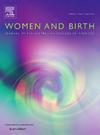“At what cost? Exploring the financial circumstances of Victorian midwifery students: A population-based cross-sectional study”
IF 4.1
2区 医学
Q1 NURSING
引用次数: 0
Abstract
Background
The Australian midwifery workforce crisis is projected to worsen. One strategy is to increase numbers of midwifery graduates. With cost-of-living pressures, tertiary education may be unaffordable for many. We need to understand financial circumstances of students to target strategies to support and sustain the future midwifery workforce.
Aim
To explore the financial circumstances of midwifery students in Victoria, Australia.
Methods
An online, population-based, cross-sectional survey conducted in 2021 was used to explore midwifery students’ financial circumstances and the impact on course experience and requirements.
Findings
Five-hundred and five midwifery students contributed to the data. Most (81 %) were in paid employment. Over half (52 %) reported needing financial support from family or ‘others’, and around two-fifths (39 %) received government support. Most anticipated a debt of between $20,000 and $50,000 on course completion. Over half (51 %) stated that they often attended university classes and paid employment in the same day, and more than half (59 %) reported that they had attended clinical placement and employment in the same day. Two-thirds responded that work commitments adversely affected performance at university. Nearly one-quarter (22 %) reported that they had needed to resign or had been dismissed from employment due to midwifery course requirements. Many reported high levels of mental and physical stress due to financial pressure and balancing paid employment with course requirements.
Conclusion
Victorian midwifery students experience high levels of financial stress and hardship with clinical placement costs creating major challenges. Identification of strategies to address midwifery student financial hardship is essential to sustaining the midwifery profession.
“代价是什么?”探索维多利亚助产学生的经济状况:一项基于人口的横断面研究”。
背景:澳大利亚助产士劳动力危机预计会恶化。其中一个策略是增加助产士毕业生的数量。由于生活成本的压力,高等教育对许多人来说可能是负担不起的。我们需要了解学生的经济状况,以便制定支持和维持未来助产士队伍的战略。目的:了解澳大利亚维多利亚州助产专业学生的经济状况。方法:采用2021年开展的一项基于人群的在线横断面调查,探讨助产学学生的经济状况及其对课程体验和要求的影响。研究发现:500名助产学学生对数据做出了贡献。大多数(81 %)从事有偿工作。超过一半(52% %)报告需要家庭或“其他人”的经济支持,约五分之二(39% %)获得政府支持。大多数人预计,在完成课程后,他们的债务将在2万至5万美元之间。超过一半(51% %)的受访者表示,他们经常在同一天参加大学课程和带薪就业,超过一半(59% %)的受访者表示,他们在同一天参加了临床实习和就业。三分之二的人回答说,工作承诺对大学表现有不利影响。近四分之一(22% %)报告说,由于助产士课程的要求,他们需要辞职或被解雇。许多人表示,由于经济压力和平衡有偿工作与课程要求,他们的精神和身体都承受着很大的压力。结论:维多利亚州的助产学学生经历了高水平的经济压力和困难,临床安置费用带来了重大挑战。确定解决助产学生经济困难的策略对维持助产专业至关重要。
本文章由计算机程序翻译,如有差异,请以英文原文为准。
求助全文
约1分钟内获得全文
求助全文
来源期刊

Women and Birth
NURSING-OBSTETRICS & GYNECOLOGY
CiteScore
7.20
自引率
13.20%
发文量
371
审稿时长
27 days
期刊介绍:
Women and Birth is the official journal of the Australian College of Midwives (ACM). It is a midwifery journal that publishes on all matters that affect women and birth, from pre-conceptual counselling, through pregnancy, birth, and the first six weeks postnatal. All papers accepted will draw from and contribute to the relevant contemporary research, policy and/or theoretical literature. We seek research papers, quality assurances papers (with ethical approval) discussion papers, clinical practice papers, case studies and original literature reviews.
Our women-centred focus is inclusive of the family, fetus and newborn, both well and sick, and covers both healthy and complex pregnancies and births. The journal seeks papers that take a woman-centred focus on maternity services, epidemiology, primary health care, reproductive psycho/physiology, midwifery practice, theory, research, education, management and leadership. We also seek relevant papers on maternal mental health and neonatal well-being, natural and complementary therapies, local, national and international policy, management, politics, economics and societal and cultural issues as they affect childbearing women and their families. Topics may include, where appropriate, neonatal care, child and family health, women’s health, related to pregnancy, birth and the postpartum, including lactation. Interprofessional papers relevant to midwifery are welcome. Articles are double blind peer-reviewed, primarily by experts in the field of the submitted work.
 求助内容:
求助内容: 应助结果提醒方式:
应助结果提醒方式:


